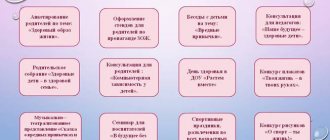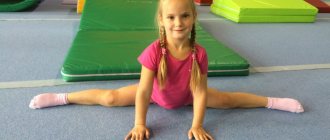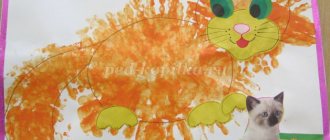Program to form the foundations of a healthy lifestyle for preschool children
4) Personal and professional growth, self-realization, moral satisfaction.
For children:
1) Developed healthy lifestyle skills. 2) Proper physical development of the child’s body, increasing its resistance to infections.
3) Improving somatic health indicators and physical fitness indicators.
4) The formation of a hygienic culture, the presence of a need for a healthy lifestyle and the possibilities of providing it.
For parents:
1) Formed active parental position. 2) Increasing the competence of parents in matters of physical development and health.
3) Active participation of parents in the life of the preschool educational institution.
Technologies for creating a healthy lifestyle
The classification of health-saving technologies in preschool education is determined by the dominance of goals and tasks to be solved, as well as the leading means of health-saving and health-enrichment of the pedagogical process in kindergarten.
In this regard, the following types of health-saving technologies can be distinguished:
Medical and preventive technologies
— technologies that ensure the preservation and enhancement of children’s health under the guidance of preschool medical personnel in accordance with medical requirements and standards, using medical supplies.
These include the following technologies:
organizing monitoring of the health of preschool children and developing recommendations for optimizing children's health;
organization and control of nutrition for children of early and preschool age, physical development of preschool children, hardening;
organization of preventive measures in kindergarten;
organization of control and assistance in meeting SanPiN requirements;
organization of a health-preserving environment in preschool educational institutions.
Physical education and health technologies
– technologies aimed at the physical development and strengthening of the child’s health: the development of physical qualities, motor activity and the formation of physical culture of preschool children, hardening, breathing exercises, massage and self-massage, prevention of flat feet and the formation of correct posture, health procedures in the aquatic environment, nurturing habits for everyday life physical activity and health care, etc. the implementation of these technologies is carried out by physical education specialists and preschool teachers in the conditions of specially organized forms of health-improving work.
Health-saving educational technologies in kindergarten
are,
first of all, technologies for educating a valeological culture or a culture of health in preschoolers. The purpose of these technologies is to develop a child’s conscious attitude towards health and human life, accumulate knowledge about health and develop the ability to protect, support and preserve it, acquire valeological competence, allowing a preschooler to independently and effectively solve the problems of a healthy lifestyle and safe behavior, tasks associated with provision of basic medical and psychological self-help and assistance.
System of work on developing a healthy lifestyle among preschool children
Evgenia Igorevna
System of work on developing a healthy lifestyle among preschool children
MOSCOW DEPARTMENT
State budgetary educational institution of the city
Moscow "School No. 1194"
PRE-SCHOOL EDUCATION TEACHERS
“MODELING ACTIVE TYPES OF CHILDREN’S ACTIVITIES IN FORMING A HEALTHY LIFESTYLE OF CHILDREN AND FAMILY ”
Speech by teacher Smirnova E.I.
«System of work on developing a healthy lifestyle among preschool children»
01/30/2018
The concept of “ health ” has many definitions. But the most popular, and perhaps the most comprehensive definition is the one given by the World Health Organization: “ Health is a state of complete physical, mental and social well-being.”
in the health of the child population throughout the world . Environmental problems, various negative household factors, chemical additives in food, poor-quality water - these are just some of the factors that aggressively affect the health of a preschooler . In this regard, the problem of cultivating the interest of every person in a healthy lifestyle .
Accordingly, one of the main tasks of any general education institution (and first of all a preschool institution , the task is to preserve and strengthen the health of preschool children , as well as the formation in children of elementary ideas about a healthy lifestyle, in any type of activity (educational, physical education , recreational activities, physical activity, etc.)
The system of working with children involves various forms , means and methods of forming ideas about a healthy lifestyle . Let's look at them.
The main forms of work are educational activities , routine moments, leisure, sports competitions and holidays.
During educational activities, children are given basic information about healthy lifestyles and reinforce the received ideas. So, for example, in classes on familiarization with the world around us, we form children’s ideas about a person as a living being, his body and health ; about the influence of various factors on human health and lifestyle ; about a healthy lifestyle ; about human behavior that promotes health and a healthy lifestyle .
In classes on familiarization with the surrounding world with an environmental focus and practical exercises, preschool children's ideas about the conditions necessary for a person to live ; about the relationship between health and the environment.
Classes in visual arts should be aimed at the implementation of productive activities of preschoolers that contribute to the expression of their ideas about healthy lifestyle in drawings, applications, crafts made from plasticine, dough, clay.
During music classes, children develop ideas about the importance of developing a person’s creative capabilities for a healthy lifestyle.
But, of course, the most effective way is to introduce children to the values of a healthy lifestyle in the process of physical education, where the need for physical activity is fully realized.
When planning work , we usually distinguish three main blocks.
1. Specially organized activities;
2. Joint activities between adults and children;
3. Free independent activity of children;
Specially organized activities include: morning exercises, physical education and physical education leisure, exercises after sleep.
In our teaching practice we use traditional, rhythmic, game, plot ( “Trip to the Zoo”
,
“Soap Bubbles”
) gymnastics.
We also conduct gymnastics after naps, the purpose of which is to improve the mood and muscle tone of children. In the gymnastics after daytime sleep, we include gentle hardening elements that have no contraindications or restrictions (air baths, washing, as well as other health procedures : breathing, finger exercises, prevention and correction of posture, flat feet, eye exercises, self-massage.
Evening time is intended to relieve fatigue. Therefore, more relaxation activities are included: minutes of pranks, joy, minutes of music and laughter therapy.
I would like to dwell in more detail on the organization of physical culture and educational leisure as a way of a value-based attitude towards health in preschool children . This is a form of work aimed at the teacher transferring motor skills and abilities to the child, developing physical qualities, curiosity, forming ideas and knowledge about the benefits of physical exercise and games, independence, and cultivating interest in active motor activity. Structurally, the process of forming a value attitude towards health and healthy lifestyle during physical education and leisure time can be represented as :
The first part is a teacher’s story or a conversation with children with the obligatory use of a literary word: a fairy tale, a story or a poem on the topic (includes reading the work, a conversation on the content (about whom, why you overtook, how to become stronger, etc.)
The second part involves performing figurative physical exercises.
The third part is an outdoor game.
The fourth part is the summary. Children exchange impressions, express their opinions about what new things they learned, what else they would like to know, etc.
At such educational events, children receive basic knowledge of hygiene ( “Make friends with a toothbrush”
, according to valeology (
“Correct posture”
,
“I will save my heart, I will help myself”,
etc.).
When children and adults work together in classes with a psychologist, children form ideas about various human states and feelings, about the human need for communication, and psychological comfort.
When performing routine moments, a special distribution of time and alternation of various types of activities during the day are implied, which are used to form and consolidate cultural and hygienic skills and hardening experience in children. For example, during sanitary and hygienic measures they create “White Gloves”
,
“Clean
palms squeak - they say thank you,” etc. At the same time,
they draw children’s attention to the quality of the activities and encourage the need for them.
Education of cultural and hygienic skills involves the formation of the habit of properly washing, drying, and taking care of one’s appearance.
However, despite all educational measures, it is worth considering that a preschool in most cases needs supervision. It is necessary to remind the child of the need to wash his hands, supervise his washing, and encourage his independence in these matters.
When organizing meals. Due to the importance of such a component of nutrition as regularity, on weekends and holidays parents are advised to adhere to the same meal schedule as in preschool . Of course, deviation from the diet is quite acceptable, justified, for example, by going out into nature, however, even in this case, it is better to eat meals as close as possible to the usual time.
When organizing walks, it is necessary to provide for health-improving activities with preschoolers - games with water, light-air and sunbathing in the warm season, outdoor games, physical education classes in the cold season.
We talked about the forms of developing a healthy lifestyle , now let’s remember the means.
The means of forming ideas about a healthy lifestyle in preschoolers are didactic and role-playing games, fiction, productive and subject-based practical activities.
In the role-playing games "Hospital"
,
“Family”
should
form in preschoolers behavior that contributes to the formation of a healthy lifestyle , based on ideas about the importance for health of ventilation of the room, its wet cleaning, washing clothes and bed linen, the use of hardening activities for the prevention of diseases, and cultural and hygienic procedures. In the game "Shop"
children learn to choose only those products that are needed for
a healthy diet .
Children's fiction promotes the development of cognitive interest in a person, his health and healthy lifestyle . Children's attention is drawn to the variety of books and their colorful design .
To form preschoolers’ ideas about healthy lifestyle, visual, verbal and practical methods are used.
Visual methods include observations, demonstrations, viewing videos, illustrations, and various exhibitions of creative works .
Direct perception of objects and phenomena during observations contributes to the development of perception and mental activity preschoolers For example, observations of plant growth in comfortable conditions form ideas about the importance , heat and water life Or observing the state of snow near highways and parking lots contributes to the formation of ideas about environmental pollution in the city by motor vehicles.
Demonstration involves showing methods of action in situations aimed at improving health and developing practical healthy lifestyle skills.
Or the participation of children and parents in exhibitions of creative works . So, for example, now in our preschool department we are implementing a child-parent creativity project “Physical education and sports in my family”
In addition to visual methods, we use verbal methods, which include teacher stories, conversations, and explanations. Stories and conversations should be aimed at providing preschoolers with the necessary information about health and healthy lifestyle , clarifying and systematizing existing ideas. Conversations can be accompanied by experiments and observations of children.
And of course, one cannot help but mention practical methods, which include experiments, exercises, subject-based practical activities, and productive activities of children. For example, experiments with water contribute to the formation of ideas about the properties of water to dissolve various substances, and therefore water may not always be clean and suitable for drinking. Experiments with sand help to consolidate children's knowledge about the properties of sand, its varieties, and the use of sand.
We must also not forget about the role of the family in the formation of a healthy lifestyle .
One of the mandatory conditions for developing a culture of health is a culture of family health . When working with families to develop the need for a healthy lifestyle in children, we use such forms of work with parents , such as newsletters , advertising booklets, thematic exhibitions, and health information corners “How I’m growing”
, consultations and conversations are held, sporting events.
Parents are regular participants in all competitions held in the preschool department .
In conclusion, I would like to add - In order to maintain the health of a child, it is necessary to unite the efforts of all the adults around him (parents, educators, doctors, teachers, etc., in order to create around him an atmosphere filled with the needs, traditions and habits of a healthy lifestyle . Thus , from an early age, a certain culture of behavior and an appropriate lifestyle are formed.Knowledge , abilities and skills of a health nature , laid down in childhood, will become a solid foundation for creating positive motivation to protect one’s own health in adulthood .





